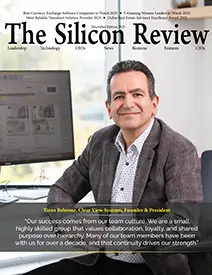50 Leading Companies of the Year 2024
Ed Garibian, CEO of LLumin and Visionary of CMMS Technology, Gives a Deeper Look into What It Takes to Be a Top 50 Company in 2024
The Silicon Review
![]()
“We architected our CMMS+ software to easily be integrated into plant and facility operations, asset management processes, and their supply chain.”
By Ed Garibian, LLumin CEO & Software Entrepreneur
Today’s manufacturing industries don’t operate in the same way as they did even a few years ago. Advancements in automation, Artificial Intelligence (AI), the Internet of Things (IoT), and Big Data have made manufacturing industries smarter. Technology has also risen the expectations of the marketplace.
At LLumin, we’ve realized that these advancements have led to the creation of a connected ecosystem between manufacturer and their customers (the end-user). Competing today requires a deeper level of customer understanding and dialog, if long-term customer satisfaction and loyalty are to be achieved. Not only listening to customers about their needs and requirements but also going one level deeper in trying to understand the challenges they face with their customers and their markets, truly matters.
![]()
Winning Approach
As the leader in computerized maintenance management systems, one focus for us has been on helping organizations track, manage, and maintain assets and critical infrastructure, effectively. Our approach is to look at the various ways we can help contribute to solving the many issues our customers face, such as bringing products to market faster, optimizing their manufacturing processes to improve product quality, and striving to keep their costs down so that they can continue to provide their customers the best pricing possible.
Another game changer that has provided many of our customers a clear competitive edge is the deployment of advanced computer maintenance management system (CMMS+) software that significantly improves how they manage their assets, employee productivity, skills, and overall inter-departmental communication and information flow.
We attribute in part the nearly 50% growth we have experienced in just the past year to how well we listen and support our customers. We’ve been able to innovate and create functionality that truly helps them increase efficiency while lowering their costs. For instance, our customers have asked us to make our CMMS+ software highly flexible, 100% HTML5 compliant, and mobile-friendly because many of the engineers say they often need multiple ways to access their crucial plant information to make informed decisions. Too often, companies don’t take to heart or even make a concerted effort to obtain feedback and input from the customers. Our growth results prove that doing so makes good business sense.
Let’s face it. Customers today are more aware than ever of the choices that are available to them and will not hesitate to take their business elsewhere if they feel that their needs aren’t being met. In this day and age, manufacturing customers (both process and discrete) are looking for more than a solution, in fact a partner -- one that cares about their needs and their customer needs as well.
Making a Difference
At LLumin, we not only look to elevate manufacturing KPIs (example: Production Volume, Asset Utilization, Operations Effectiveness, etc.) but also make sure our manufacturing customers are happy by having adopted a holistic approach, which combines manufacturing KPIs with customer service KPIs. For instance, our customers were able to save an average 23% savings by improving collaboration throughout their operations. We architected our CMMS+ software to easily be integrated into plant and facility operations, asset management processes, and their supply chain. By addressing these three challenging areas, customers were finally able to effectively streamline maintenance and maintenance management activities, create a happier workforce because of the better use of staff resources, and of course, lower manufacturing costs while still producing quality products, a key KPI at the enterprise level.
Maintenance personnel achieved significant increases in machine and equipment uptime by an average of 20- 25%, which for a 24/7 operation could save them from losing $1M-$2M. Not only enabling data exchange between maintenance operations and production processes is key, the real- time monitoring of data regarding machine health can also be important in optimizing plant performance. The system can create alerts to be able to pro-actively repair machines before any bigger issues occur.
Managing a materials supply chain, management liked that they could provide enterprise-level visibility with inventory, purchasing, and usage tracking capabilities. Also, by being able to maintain operations (MRO) inventory levels and optimize replenishment through streamlined procurement workflows, they appreciated having everything automated from purchase order creation, authorization, and receiving (even invoice matching) to being able to conduct a complete inventory analysis very easily and seamlessly as needed.
With supply chain partners, our customers shared that having the ability to gain deeper insights into MRO vendor performance makes a tremendous difference in getting repairs and overall maintenance work completed faster. This not only greatly improves their MTTR and PM Compliance percentage levels, but very quickly impacts many production metrics, including on-time delivery, product quality, and customer service. The capability of intelligently being able to evaluate vendors and make informed decisions about which suppliers to work with is hugely valuable.
![]()
Continuous Improvement Matters
With customers’ requests for more user-friendly dashboards, we listened and improved visibility across departmental teams, giving stakeholders keen insights into current and previous work orders and equipment performance. This helped unlock new levels of continuous improvement and facilitated reporting for compliance and commitments. For instance, some compliance reports require data and history from machine operations, maintenance work orders, and supply chain vendor transactions. The fact that these reports can be automated, scheduled, and either displayed upon login or shared via email notifications reduced communication breakdowns and even eliminated many time-consuming administrative activities.
Managing maintenance and engineering personnel scheduling is another continuous improvement area that customers appreciate because the system accurately tracks the time taken to complete tasks and delivers the analytics and continuous learning tools needed to streamline ongoing labor and skills coordination.
Through all this customer, partner, and employee input we value and are acting on, in addition to the amazing growth we’re experiencing as a company, we’re making a huge, positive impact on our manufacturing customers’ bottom lines. We will continue to focus on building lasting customer relationships, investing in a great corporate culture and creating the best CMMS+ systems possible.
_2025-12-15_12-44-58.webp)


_2025-11-17_06-38-14.webp)

 (1)_2025-10-21_13-35-14.webp)
